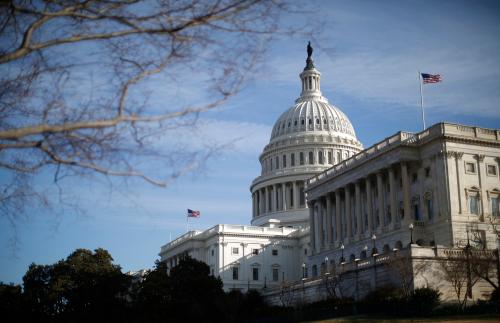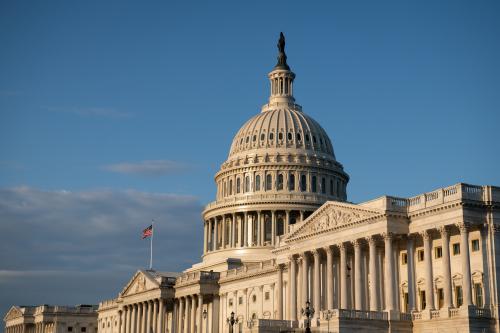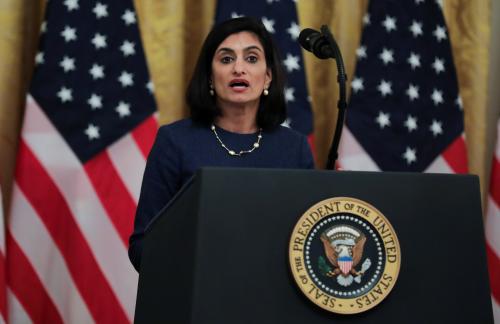Oversight actions in this article have been identified by the Brookings House Oversight Tracker.
Since regaining the majority in January, House Democrats have been conducting oversight of the Trump administration on issues ranging from family separation at the border to the rollback of environmental regulations. While the policy areas addressed by these investigations are diverse, House committees often apply the same tools to perform oversight. As Congress attempts to exert influence on the White House in hopes of obtaining information, Trump administration officials continue to utilize several tactics of their own to stall the process.
As part of its mandate to conduct oversight of “the operation of Government activities at all levels,” the House Oversight and Reform Committee is frequently engaged in conflicts with the executive branch over information access. One such clash during the 116th Congress has involved the White House security clearance process, which came under fire when media reports indicated that the administration allowed individuals to operate under interim security clearances for extended periods and ignored concerns raised by intelligence officials. Here, we outline the ongoing security clearance investigation and use it to highlight a set of common steps in the oversight process.
The initial inquiry
In 2017, following media reports indicating that former National Security Advisor Michael Flynn’s consulting firm accepted payments from Turkish sources, Oversight Committee members sought more information about Flynn’s background and his possession of a security clearance despite his foreign connections. The following year, the Chair of the House Oversight and Government Reform Committee Trey Gowdy (R-S.C.) wrote a letter to White House Chief of Staff John Kelly informing him that the Committee launched an investigation into the interim security clearance process. In December 2018, the new chairman, Elijah Cummings (D-Md.), communicated to Kelly that the new majority was intent on continuing that investigation.
When conducting oversight, members of Congress have several tools at their disposal. Most notably, they can request documents, call witnesses to testify, issue subpoenas, and hold individuals in contempt of Congress for noncompliance. Oversight investigations are often initiated by an official request for information, usually in the form of a letter written by a committee chair to an executive branch official. The chair uses this correspondence to ask for documents and/or to invite a witness to give testimony before the committee.
To continue the investigation into the security clearance process at the start of the 116th Congress, Cummings sent a letter to Counselor to the President Pat Cipollone seeking information about the degree to which the administration disregarded usual procedures. After noting that the White House neglected to respond to the inquiries of the last Congress, Cummings requested that the administration turn over 13 types of documents, including but not limited to, documentation of any changes made to the security clearance process, communications within the Trump transition team related to security clearances, and individual background files.
Legislative vs. executive power
After a committee requests information, the communication between Congress and the administration can to turn into a debate about legislative and executive power. When this happens, officials in both branches present legal reasoning for their requests and/or denials of information, often attempting to counter the arguments made by their inter-branch adversaries with competing claims.
In a response to Chairman Cummings sent on January 31st, Cipollone asserted that congressional oversight should be “narrowly focused and limited.” On March 4th, he claimed that the security clearance investigation did not “serve a legitimate legislative purpose.” The notion that congressional investigative powers must only be used “in aid of the legislative function” dates to an 1880 Supreme Court decision in Kilbourn v. Thompson. This reasoning has been deployed repeatedly as part of the Trump administration’s pushback against congressional oversight. Treasury Secretary Steven Mnuchin, for example, used the same language as Cipollone to explain to House Ways and Means Committee Chairman Richard Neal (D-Mass.) why he would not turn over the president’s tax returns.
Cipollone’s arguments also centered on the president’s discretion regarding security clearances. In the January letter, Cipollone demonstrated this point by referencing a Supreme Court case, Dep’t of the Navy v. Egan, which held that the president has the “authority to classify and control access to information bearing on national security.” Chairman Cummings responded that the Constitution grants Congress the authority to dictate government regulations and pass laws to protect the country’s national security information. He also later argued that Congress has the responsibility to investigate any issue, including “who has been given access to our nation’s secrets, how they obtained that access, [and] the extent to which national security has been compromised.”
Compromise: Real or illusory?
Sometimes, the executive and legislative branches can reach true compromise. For example, when determining if Special Counsel Robert Mueller would testify about his report, his aides and the staffs of the Judiciary and Intelligence Committees spent weeks communicating about the conditions of his testimony. In the end, Mueller agreed to appear if both committees questioned him on the same day and for a limited time.
Even when compromise is illusory, however, both Congress and the administration have reason to try to appear as though they have been extremely accommodating and that the other side is refusing to cooperate. After all, appearing reasonable and competent in the eyes of the public can be a valuable electoral strategy.
On one hand, the administration does its best to appear cooperative. In the letter sent on March 4, Cipollone asserted that his office had worked with the committee by responding to letters, meeting with Cummings, holding briefings, and providing some documents. In the same letter, Cipollone described the committee’s actions as premature and unprecedented. He claimed that the committee was unwarranted in its requests, seeking “unilateral concessions without any offer of accommodation on its part.”
In response, Cummings touted his own lenience with the administration, stating that the committee provided “every possible opportunity” for the White House to cooperate. He described his committee’s actions as more than fair, as it gave the administration months to deliver the documents.
This stage of negotiations can go on for long stretches of time. There are at least seven letters sent between the Cummings and Cipollone that include this type of language.
Issuing subpoenas
When the executive branch rejects the committee’s requests for documents, Congress can deploy legal measures aimed at compelling the administration to cooperate. One such maneuver is the subpoena, which requires the administration to hand over documents or provide testimony under threat of legal punishment.
After hearing testimony from whistleblower Tricia Newbold, who revealed that the administration overturned dozens of security clearance denials, the committee moved to issue subpoenas for depositions from administration officials. The first subpoena was delivered to Carl Kline, former White House Personnel Security Director. Kline’s testimony was a priority because he oversaw the security clearance process and was accused by Newbold of discrimination.
Once the subpoena was delivered, Cipollone threatened to prevent Kline from testifying by directing him not to comply, which is rather unusual. Cummings then reminded Kline that subpoena recipients are responsible for responding to the committee, regardless of direction received from their superiors. With this forceful warning from Cummings, Kline agreed to appear for a deposition following approval from the White House.
In this instance, the power to subpoena was critical for Congress to make progress in its oversight efforts, as the threat of penalty was likely what prompted Kline to engage. During his private interview with the committee, Kline took full responsibility for the defects in the security clearance process, defending the president and Chief of Staff Kelly.
Contempt and other legal actions
When an individual ignores a congressional subpoena, a committee can hold that individual in contempt of Congress under the criminal contempt statute, thereby recommending them for prosecution. If the full House approves such a resolution, the Speaker of the House delivers the citation to the Department of Justice, proposing that a federal prosecutor present the case to a grand jury. Critically, under the criminal contempt approach, subpoenas can only be enforced by administration-appointed Department of Justice officials, yet the department has a stated policy of non-enforcement if subpoenas are being ignored at the direction of the president.
Because Kline agreed to an interview, there was no need to pursue this step. However, in a case involving Attorney General William Barr, Commerce Secretary Wilbur Ross, and the 2020 census, Cummings followed through with scheduling a contempt vote in an attempt to secure compliance. The chairman notified Barr and Ross that a vote had been scheduled but left an opening for the committee to “consider postponing its contempt vote” if Barr and Ross provided certain documents by a specific deadline.
Since Barr and Ross declined this opportunity, the House did vote to hold them in contempt, but the Justice Department is unlikely to act on the referral. Alternatively, Congress can pursue civil enforcement of a subpoena as a way of forcing an executive branch official to comply with their requests. This process recently began, for example, in a separate case for former White House Counsel Don McGahn when the Judiciary Committee Chairman filed a lawsuit to enforce a subpoena for his testimony concerning the Russia Investigation.
Conclusion
The Trump administration’s response to congressional oversight efforts has demonstrated that extracting information concerning executive agencies and actions is not easy. As committees continue to demand answers through the oversight process, the White House frequently stonewalls their requests. With tensions mounting between these two branches of government, it appears that more legal actions may follow; with the speed at which these issues typically move through the courts, it could be a slow and tedious process.










Commentary
Anatomy of an oversight investigation: White House security clearances
August 26, 2019